Long-Term Land Use and Landscape Pattern Changes in a Marshland of Hungary
Abstract
:1. Introduction
2. Materials and Methods
2.1. Study Area
2.2. Methods to Study Land Use/Land Cover Change
| CORINE Nomenclature | Our Land Use Types | Map Generalization Method to Ensure Similar Richness of Detail |
|---|---|---|
| 4.1.1. Inland marshes | Wetland | amalgamation, merging, selection Sample and description: [30] pp. 105–107. Modification of CLC nomenclature guidelines: minimum area is 0.25 hectare |
| 2.3.1. Pastures 2.4.3. Land principally occupied by agriculture, with significant areas of natural vegetation 3.2.1. Natural grasslands | Grassland | amalgamation, merging, selection Sample and description: [30] pp. 52–64, and 75–81. Modification of CLC nomenclature guidelines: minimum area is 0.25 hectare |
| 2.1.1. Non-irrigated arable land | Arable land | amalgamation, merging Sample and description: [30] pp. 39–42. Modification of CLC nomenclature guidelines: minimum area is 0.25 hectare |
| 5.1.2. Water bodies | Water surface | amalgamation, merging, selection Sample and description: [30] pp. 116–119. Modification of CLC nomenclature guidelines: minimum area is 0.25 hectare |
| 2.2.1. Vineyards 2.2.2. Fruit trees and berry plantations 2.4.2. Complex cultivation patterns | Vineyard, garden, orchard | amalgamation, classification, merging, selection, simplification Sample and description: [30] pp. 45–50. and 59–61. Modification of CLC nomenclature guidelines: minimum area is 0.25 hectare; distance for merging: 30 m. |
| 1.1.2. Discontinuous urban fabric 1.2.1. Industrial or commercial units 1.2.2. Road and rail networks and associated land 1.4.2. Sport and leisure facilities | Built-up area | aggregation, amalgamation, merging, selection Sample and description: [30] pp. 10–23. and 35–37. Modification of CLC nomenclature guidelines: minimum area is 0.25 hectare |
| 3.1.1. Broad-leaved forest 3.1.3. Mixed forest | Forest | aggregation, amalgamation, classification, merging, selection, simplification Sample and description: [30] pp. 69–75. Modification of CLC nomenclature guidelines: minimum area is 0.25 hectare; distance for merging: 30 m |
| 3.2.4. Transitional woodland-shrub | Scrub | aggregation, amalgamation, classification, merging, selection, simplification Sample and description: [30] pp. 87–92. Modification of CLC nomenclature guidelines: minimum area is 0.25 hectare; distance for merging: 30 m |
2.3. Methods to Study Landscape Pattern Change
- TE (Total Edge): the total length of edges in a given patch type or landscape; suitable for landscape history analyses: for patches of similar sizes heterogeneity increases with growing TE.
- ED (Edge Density): length of edges per unit area; allows the comparison of landscapes of different sizes or the degree of fragmentation of patches.
- NP (Number of Patches): total number of patches of the same type or within a landscape; a component of more complex indicators for landscapes of similar sizes or for historical evolution but no information of area, density or distribution.
- SHDI (Shannon’s Diversity Index): richness of patches; high SHDI means the proportional distribution of patches, if there is only one patch, SHDI is 0.
- SHEI (Shannon’s Evenness Index): shows the uniformity of patch type distribution; if one patch dominates, SHEI is close to 0, if there is only one patch, SHDI is 0.
- D (Dominance): one or more patch type dominates in an area; complements SHEI as values close to 0 mean maximum evenness.
- TE (Total Edge) and NP (Number of Patches): see above.
- MPE (Mean Patch Edge): medium size of a given patch class (what is the average edge length of patches); more complex than TE as considers NP too.
- CA (Class Area): total area of the patch class; informs about landscape pattern, how prominent a patch type is in the landscape.
- MPS (Mean Patch Size): average size for patches in one class; indicates landscape heterogeneity and allows comparisons among landscapes.
- PSSD (Patch Size Standard Deviation): changes with MPS and patch size; indicates the variability of patch size.
- DIVISION: based on cumulative distribution, shows the probability that two randomly selected points lie within different patches; it is 0 if there is only one patch; correlates negatively with MESH.
- SPLIT (Splitting Index): also based on cumulative distribution, correlated with DIVISION; if there is only one patch, it is 1; the more the patches, the higher the value;
- MESH (Effective Mesh Size): based on cumulative distribution, the higher its value, the more probable it is that two randomly selected points are within one patch; depends on the distribution of patch sizes and the proportion of the patch class within the landscape unit.
3. Results and Discussion
3.1. Land Use at the Time of the First Military Survey (1783–1784)
3.2. Landscape Pattern at the Time of the First Military Survey (1783–1784)
3.3. Land Use at the Time of the Second Military Survey (1852–1857)
3.4. Landscape Pattern at the Time of the Second Military Survey (1852–1857)
3.5. Land Use at the Time of the Third Military Survey (1880–1882)
3.6. Landscape Pattern at the Time of the Third Military Survey (1880–1882)
3.7. Land Use in 1941
3.8. Landscape Pattern in 1941
3.9. Land Use at the Time of the 1950–1952 Military Survey
3.10. Landscape Pattern at the Time of the 1950–1952 Military Survey
3.11. Land Use in the 1980s
3.12. Landscape Pattern in the 1980s
3.13. Land Use Today (2018–2020)
3.14. Landscape Pattern Today (2018–2020)
3.15. Changes in Land Use Classes
3.16. Opportunities for Landscape Rehabilitation
4. Conclusions
Author Contributions
Funding
Institutional Review Board Statement
Informed Consent Statement
Data Availability Statement
Acknowledgments
Conflicts of Interest
References
- Berényi, I. Kultúrtájváltozás a 18. században (Changes in cultural landscape in the 18th century). In A Kárpát-Medence Földrajza (Geography of the Carpathian Basin); Dövényi, Z., Ed.; Akadémiai Kiadó: Budapest, Hungary, 2012; pp. 386–389. [Google Scholar]
- Burton, T.M.; Uzarski, D.G. Marshes-Non-wooded Wetlands. In Encyclopedia of Inland Waters; Elsevier: Amsterdam, The Netherlands; Boston, MA, USA, 2009; pp. 531–540. ISBN 978-0-12-370626-3. [Google Scholar]
- Zorrilla-Miras, P.; Palomo, I.; Gómez-Baggethun, E.; Martín-López, B.; Lomas, P.L.; Montes, C. Effects of Land-Use Change on Wetland Ecosystem Services: A Case Study in the Doñana Marshes (SW Spain). Landsc. Urban Plan. 2014, 122, 160–174. [Google Scholar] [CrossRef]
- Turner, M.G.; Gardner, R.H. Landscape Ecology in Theory and Practice; Springer: New York, NY, USA, 2015; ISBN 978-1-4939-2793-7. [Google Scholar]
- McGarigal, K. Landscape pattern metrics. In Encyclopedia of Environmetrics; Abdel, H.E.-S., Walter, W.P., Eds.; John Wiley & Sons: Chichester, UK, 2002; pp. 1135–1142. [Google Scholar]
- Riitters, K. Pattern Metrics for a Transdisciplinary Landscape Ecology. Landsc. Ecol. 2019, 34, 2057–2063. [Google Scholar] [CrossRef] [Green Version]
- Túri, Z. A Tájmintázat Vizsgálata a Tiszazugban (Landscape Pattern in the Tiszazug). Tájökológiai Lapok 2011, 9, 43–51. [Google Scholar]
- Csorba, P. Magyarország Kistájai (Microregions of Hungary); Meridián Táj- és Környezetföldrajzi Alapítvány: Debrecen, Hungary, 2021; ISBN 978-963-89712-4-1. [Google Scholar]
- Tarnawa, Á.; Pósa, B.; Kassai, K.; Nyárai, F.H.; Farkas, A.; Birkás, M.; Jolánkai, M. Climate Change Research Review–10th Anniversary of the VAHAVA Report. Columella 2017, 4, 55–62. [Google Scholar] [CrossRef]
- Nagy, G.; Lóczy, D.; Czigány, S.; Pirkhoffer, E.; Fábián, S.Á.; Ciglič, R.; Ferk, M. Soil Moisture Retention on Slopes under Different Agricultural Land Uses in Hilly Regions of Southern Transdanubia. HunGeoBull 2020, 69, 263–280. [Google Scholar] [CrossRef]
- Magyarország Kistájainak Katasztere (Inventory of the Microregions of Hungary), 2nd ed.; Dövényi, Z. (Ed.) MTA Földrajztudományi Kutatóintézet: Budapest, Hungary, 2010; ISBN 978-963-9545-29-8. [Google Scholar]
- Második Katonai Felmérés (Second Military Survey). Königreich Ungarn. Digitized Maps of the Habsburg Empire 1806–1869 (1:28800); DVD; Arcanum Adatbázis Kft: Budapest, Hungary, 2005. [Google Scholar]
- Mezősi, G. A Dunántúli-dombság nagyobb tájföldrajzi egységeinek genetikai vázlata és természetföldrajzának néhány kérdése (The origin and physical geography of major landscape units of the Transdanubian Hills). In Magyarország Természetföldrajza (Physical Geography of Hungary); Akadémiai Kiadó: Budapest, Hungary, 2011; pp. 299–304. [Google Scholar]
- Hahn, G. Magyarország Tőzeg- És Lápföldvagyona (Peat and Muck Reserves in Hungary). Földtani Kut. 1984, 27, 85–94. [Google Scholar]
- Károlyi, Z.; Vázsonyi, Á. A Balaton és vízrendszere (Lake Balaton and its drainage system). In A magyar Vízszabályozás Története (History of Water Regulation in Hungary); Ihrig, D., Ed.; Országos Vízügyi Hivatal: Budapest, Hungary, 1973; pp. 249–271. [Google Scholar]
- Dömsödi, J. Adatok a Nagyberek És Környéke Lápterületeinek Hasznosításához (Data on the Utilization of the Bogs in the Nagyberek and Its Environs). Agrokémia Talajt. 1976, 25, 115–130. [Google Scholar]
- Nagy, G.G. Nagyberek Természetföldrajza (Physical Geography of the Nagyberek), Budapesti Corvinus Egyetem, Tájépítészeti Kar; Tájtervezési és Területfejlesztési Tanszék: Budapest, Hungary, 2011. [Google Scholar]
- József, L.; György, R.; Gabriella, S.L. A Pogány-Völgyi Rétek Natura 2000 Terület Kisemlős Közösségeinek Vizsgálata, Különös Tekintettel Az Északi Pocok (Microtus Oeconomus) Előfordulására. Nat. Som. 2015, 27, 107–114. [Google Scholar] [CrossRef]
- Ferincz, Á.; Ádám, S.; András, W.; Sütő, S.; Soczó, G.; Ács, A.; Kováts, N.; Paulovits, G. Adatok a Dél-Balatoni Berekterületek Halfaunájához. Nat. Som. 2014, 24, 279–286. [Google Scholar]
- Magyarország Kételtűi És Hüllői: Keresztes Vipera. Available online: https://www.mme.hu/keteltuek-es-hullok/keresztes-vipera (accessed on 6 November 2021).
- Natura 2000-Standard Data form Balatoni Berkek. Available online: https://natura2000.eea.europa.eu/Natura2000/SDF.aspx?site=HUDD10012 (accessed on 6 November 2021).
- Kovács, G.; Jakus, L. A Tóközi-Berek (Zamárdi) Madártani Felmérése [The Ornithological Survey of the Tóközi-Berek (Marsh) at Zamárdi]. Nat. Som. 2015, 26, 117–122. [Google Scholar]
- Ancsin, G. Egy Elfeledett Ősmocsár–A Balatoni Nagy-Berek (A Forgotten Ancient Swamp, the Nagy-Berek of Lake Balaton). Available online: https://afoldgomb.hu/magazin/a-foldgomb-2019-tavaszi-kulonszam/egy-elfeledett-osmocsar-a-balatoni-nagy-berek (accessed on 15 September 2021).
- Első Katonai Felmérés (First Military Survey). Königreich Ungarn. Digitized Maps of the Habsburg Empire 1763–1785 (1:28,800), DVD.; Arcanum Adatbázis Kft: Budapest, Hungary, 2004. [Google Scholar]
- Harmadik Katonai Felmérés (Third Military Survey). Königreich Ungarn. Digitized Maps of the Habsburg Empire 1869–1887 (1:25000), DVD.; Arcanum Adatbázis Kft: Budapest, Hungary, 2007. [Google Scholar]
- Magyarország Katonai Felmérése 1941 (Military Survey of Hungary in 1941), (1:25,000); HM Hadtörténeti Intézet És Múzeum Térképtára: Budapest, Hungary, 1941.
- A Magyar Néphadsereg 1951-Ben Helyesbített, 1952-Ben Kiadott Térképszelvényei (Map Sections Created by Hungarian People’s Army, Corrected in 1951, Published in 1952), (1:25,000); (Hungarian People’s Army): Budapest, Hungary.
- Magyarország EOTR Topográfiai Felmérése 1980–1989 (EOTR Topographic Survey of Hungary 1980–1989) (1:10000); Mezőgazdasági És Élelmezésügyi Minisztérium: Budapest, Hungary, 1989.
- European Environment Agency Corine Land Cover (CLC). 2018. Available online: https://land.copernicus.eu/pan-european/corine-land-cover/clc2018 (accessed on 16 August 2021).
- Kosztra, B.; Büttner, G.; Hazeu, G.; Arnold, S. Updated CLC Illustrated Nomenclature Guidelines 2019; European Environment Agency: Wien, Austria, 2017; pp. 1–24. [Google Scholar]
- Shea, K.S.; Master, R.B.M. Cartographic Generalization in a Digital Environment: When and How to Generalize; American Society for Photogrammetry and Remote Sensing and American Congress on Surveying and Mapping: Falls Church, VA, USA, 1989; pp. 56–67. [Google Scholar]
- Susetyo, D.B.; Hidayat, F. Specification of Map Generalization from Large Scale to Small Scale Based on Existing Data. IOP Conf. Ser. Earth Environ. Sci. 2019, 280. [Google Scholar] [CrossRef]
- CLC Nomenclature Guidelines. Available online: https://land.copernicus.eu/user-corner/technical-library/corine-land-cover-nomenclature-guidelines/html (accessed on 20 September 2021).
- Copernicus Open Access Hub-Sentinel-2 Image. Available online: https://scihub.copernicus.eu/dhus/odata/v1/Products(’0d47cb1c-a1b1-4e5b-bc79-2f4fcd91115f’)/$value (accessed on 16 August 2021).
- Copernicus Open Access Hub-Sentinel-2 Image. Available online: https://scihub.copernicus.eu/dhus/odata/v1/Products(’91c6b176-412a-4581-af4f-c76ff64133aa’)/$value (accessed on 17 August 2021).
- Szabó, L.; Deák, M.; Szabó, S. Comparative Analysis of Landsat TM, ETM+, OLI and EO-1 ALI Satellite Images at the Tisza-Tó Area, Hungary. Landsc. Environ. 2016, 10, 53–62. [Google Scholar] [CrossRef]
- Forman, R.T.T.; Godron, M. Landscape Ecology; John Wiley and Sons: New York, NY, USA, 1986; ISBN 978-0-471-87037-1. [Google Scholar]
- Kerényi, A. Tájvédelem (Landscape Protection); Pedellus Tankönyvkiadó: Debrecen, Hungary, 2007; ISBN 978-963-9612-54-9. [Google Scholar]
- Csorba, P.; Horváth, G.; Mezősi, G.; Lóczy, D.; Mucsi, L.; Szabó, M. Geoökológiai Alapú Tájtervezés Elméleti És Gyakorlati Kérdései (Theory and Practice of Geoecological Landscape Planning); Szegedi Tudományegyetem: Szeged, Hungary, 2013. [Google Scholar]
- Szabó, S. Tájmetriai Mérőszámok Alkalmazási Lehetőségeinek Vizsgálata a Tájanalízisben (Opportunities for the Application of Landscape Indices in Landscape Analysis). Ph.D. Thesis, Debreceni Egyetem Természettudományi és Technológiai Kar, Debrecen, Hungary, 2009. [Google Scholar]
- Csorba, P.; Szabó, S. The Application of Landscape Indices in Landscape Ecology. In Perspectives on Nature Conservation-Patterns, Pressures and Prospects; Tiefenbacher, J., Ed.; InTech: London, UK, 2012. [Google Scholar]
- Vector-Based Landscape Analysis Tools (Extension for ArcGIS 10.8): V-LATE 2.0 (Programming: Dirk Tiede). Available online: https://hub.arcgis.com/content/69963ab422d04e649b64ac11cbadafed/about (accessed on 16 August 2021).
- Túri, Z. A Tájszerkezet Geoinformatikai Módszereinek Elemzése Alföldi Mintaterületen (Landscape Pattern Analysis by GIS in a Lowland Area); Debreceni Egyetem Természettudományi Doktori Tanács Földtudományok Doktori Iskola: Debrecen, Hungary, 2015. [Google Scholar]
- O’Neill, R.V.; Krummel, J.R.; Gardner, R.H.; Sugihara, G.; Jackson, B.; DeAngelis, D.L.; Milne, B.T.; Turner, M.G.; Zygmunt, B.; Christensen, S.W.; et al. Indices of Landscape Pattern. Landsc. Ecol. 1988, 1, 153–162. [Google Scholar] [CrossRef]
- McGarigal, K.; Marks, B.J. FRAGSTATS: Spatial Pattern Analysis Program for Quantifying Landscape Structure; U.S. Department of Agriculture, Forest Service, Pacific Northwest Research Station: Portland, OR, USA, 1995; p. PNW-GTR-351. [Google Scholar]
- Jaeger, J.A.G. Landscape Division, Splitting Index, and Effective Mesh Size: New Measures of Landscape Fragmentation. Landsc. Ecol. 2000, 15, 115–130. [Google Scholar] [CrossRef]
- IDEFIX—Integration Einer Indikatorendatenbank für Landscape Metrics in ArcGIS 8.x. Available online: http://www.agit.at/s_c/papers/2003/1645.pdf (accessed on 1 August 2021).
- Lang, S.; Tiede, D. vLATE Extension für ArcGIS–Vektorbasiertes Tool zur Quantitativen Landschaftsstrukturanalyse. Available online: https://uni-salzburg.elsevierpure.com/en/publications/vlate-extension-f%C3%BCr-arcgis-vektorbasiertes-tool-zur-quantitativen (accessed on 13 August 2021).
- McGarigal, K.; Marks, B.J. Fragstats. Available online: https://www.umass.edu/landeco/pubs/mcgarigal.marks.1995.pdf (accessed on 11 October 2021).
- Bendefy, L. A Balaton Vízszintjének Változásai a Neolitikumtól Napjainkig (Water Level Changes of Lake Balaton from the Neolithic to the Present Day). Hidrológiai Közlöny 1968, 48, 257–262. [Google Scholar]
- NAGY-BEREK Fehér-Vízi Láp (Nagy-Berek, Fehér-Víz Bog); Temesi, I. (Ed.) Tájak–Korok–Múzeumok Szervező Bizottsága és az Országos Környezet-és Természetvédelmi Hivatal: Budapest, Hungary, 1983; ISBN 963-555-186-X. [Google Scholar]
- Milberg, P.; Bergman, K.; Jonason, D.; Karlsson, J.; Westerberg, L. Forest Ecology and Management Land-Use History in Fl Uence the Vegetation in Coniferous Production Forests in Southern Sweden. For. Ecol. Manag. 2019, 440, 23–30. [Google Scholar] [CrossRef]
- Rozner, G.; Miókovics, E.; Vidéki, R. Védett Növényfajok Előfordulási Adatai Észak-Somogyban. Nat. Som. 2011, 19, 5–16. [Google Scholar]
- Everard, M.; Jevons, S. Ecosystem Services Assessment of Buffer Zone Installation on the Upper Bristol Avon, Wiltshire; Environment Agency: Bristol, UK, 2010; ISBN 978-1-84911-176-8. [Google Scholar]
- Szabó, I.; Balázsy, S.; Végső, Z.; Jens, M.; Vajda, P. A Forgatás Nélküli Mulcsos Talajművelés Mint a Tarlómaradványok Mikrobiális Lebontásának Leghatékonyabb Technológiája (Mulching without Ploughing as the Most Effective Technology for the Microbiological Decomposition of Stubble Residues). Környezetkímélő Talajművelési Rendszerek Magyarországon. Available online: http://www.mtafki.hu/konyvtar/kiadv/ktrm/pdf/010_Szabo.pdf (accessed on 7 May 2021).
- Ramsar Sites Information Service—Fishponds and Marshlands South of Lake Balaton. Available online: https://rsis.ramsar.org/ris/1963 (accessed on 16 September 2021).
- Friesz, K. Zamárdi a XX. században (Zamárdi in the 20th century). In ZAMÁRDI Községtörténeti Tanulmányok; Zamárdi nagyközség képviselő-testülete: Zamárdi, Hungary, 1997; ISBN 963-03-4296-0. [Google Scholar]
- Kozák, L. Élőhely-Kezelés (Habitat Management); Debreceni Egyetem. Agrár—és Gazdálkodástudományok Centruma: Debrecen, Hungary, 2011. [Google Scholar]
- Konkoly-Gyuró, É.; Tirászi, Á.; Balázs, P.; Nagy, D.; Király, G. A vízrendszer, a felszínborítás és a tájkarakter változása a Fertő-Hanság medencében (Changes of the watercourse system, land cover and landscape character in the Fertő-Hanság basin). In A táj Változásai a Kárpát-Medencében (Landscape Changes in the Carpathian Basin); Sopron, Hungary, 2014; pp. 42–48. Available online: http://www.emk.nyme.hu/fileadmin/dokumentumok/emk/evgi/TajTanszek/Publik%C3%A1ci%C3%B3k/Konkoly-Gyur%C3%B3_etal_V%C3%ADzrendszer_felsz%C3%ADnbor%C3%ADt%C3%A1s_Fert%C5%91_f.pdf (accessed on 8 August 2021).
- Molnár, Z.; Gergely, A. A Körtvélyes-Sziget Élőhely-Változásai (Habitat Changes of the Körtvélyes-Island). Tájokológiai Lapok 2008, 6, 333–341. [Google Scholar]
- Ujházy, N.; Bíró, M. A Vizes Élőhelyek Változásai Szabadszállás Határában (Changes of Wetlands on the Border of Szabadszállás). Tájökológiai Lapok 2013, 11, 291–310. [Google Scholar]
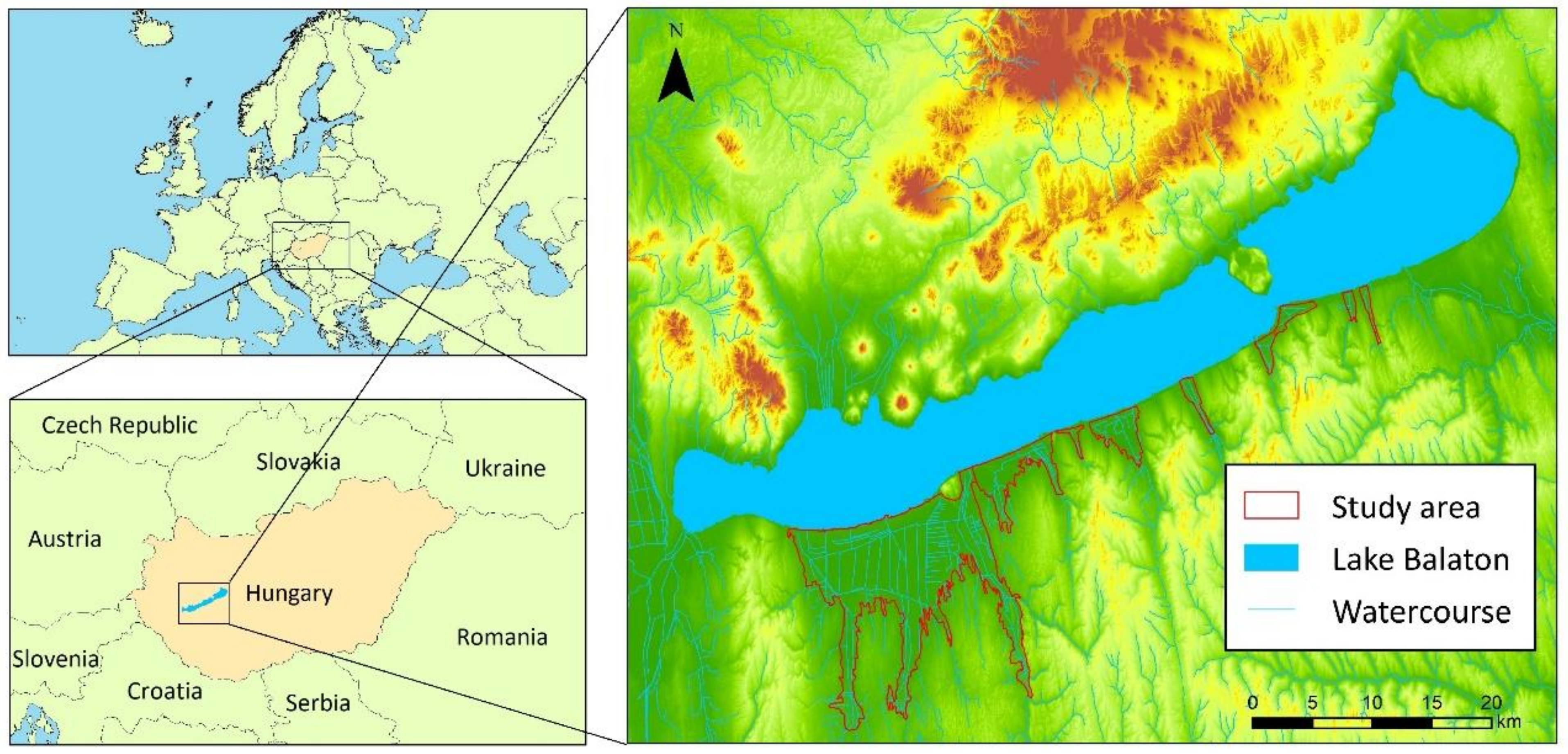
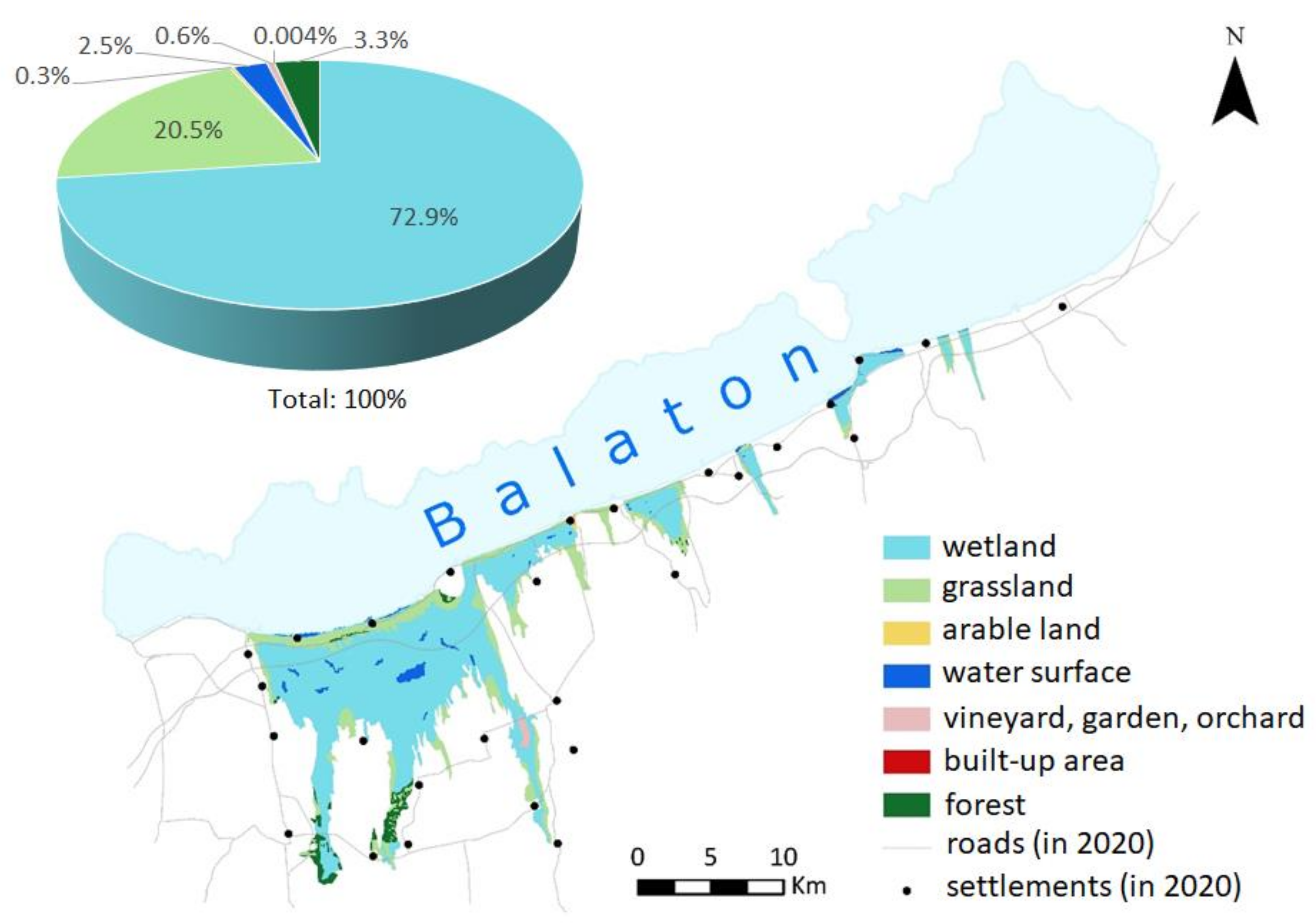
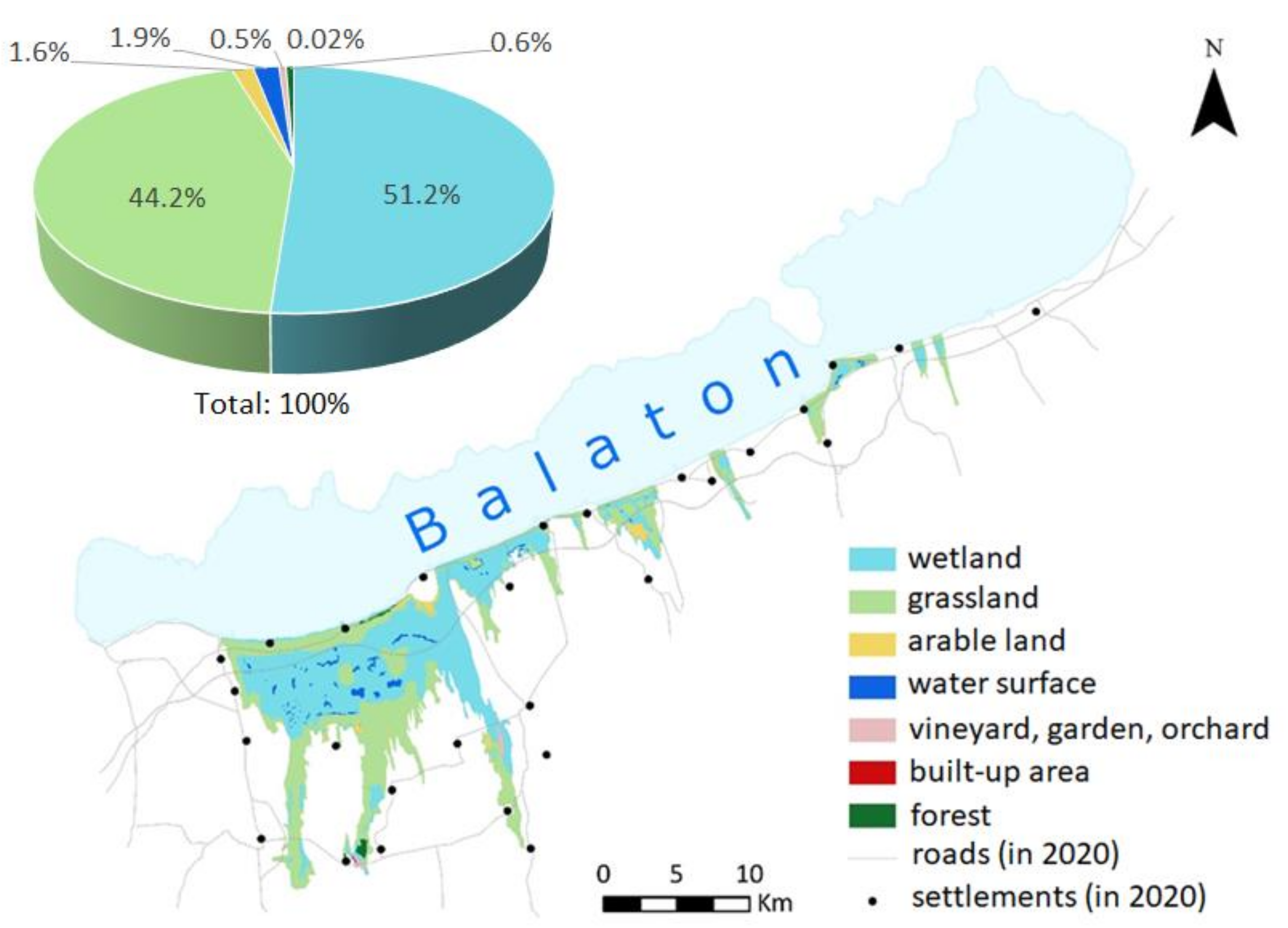


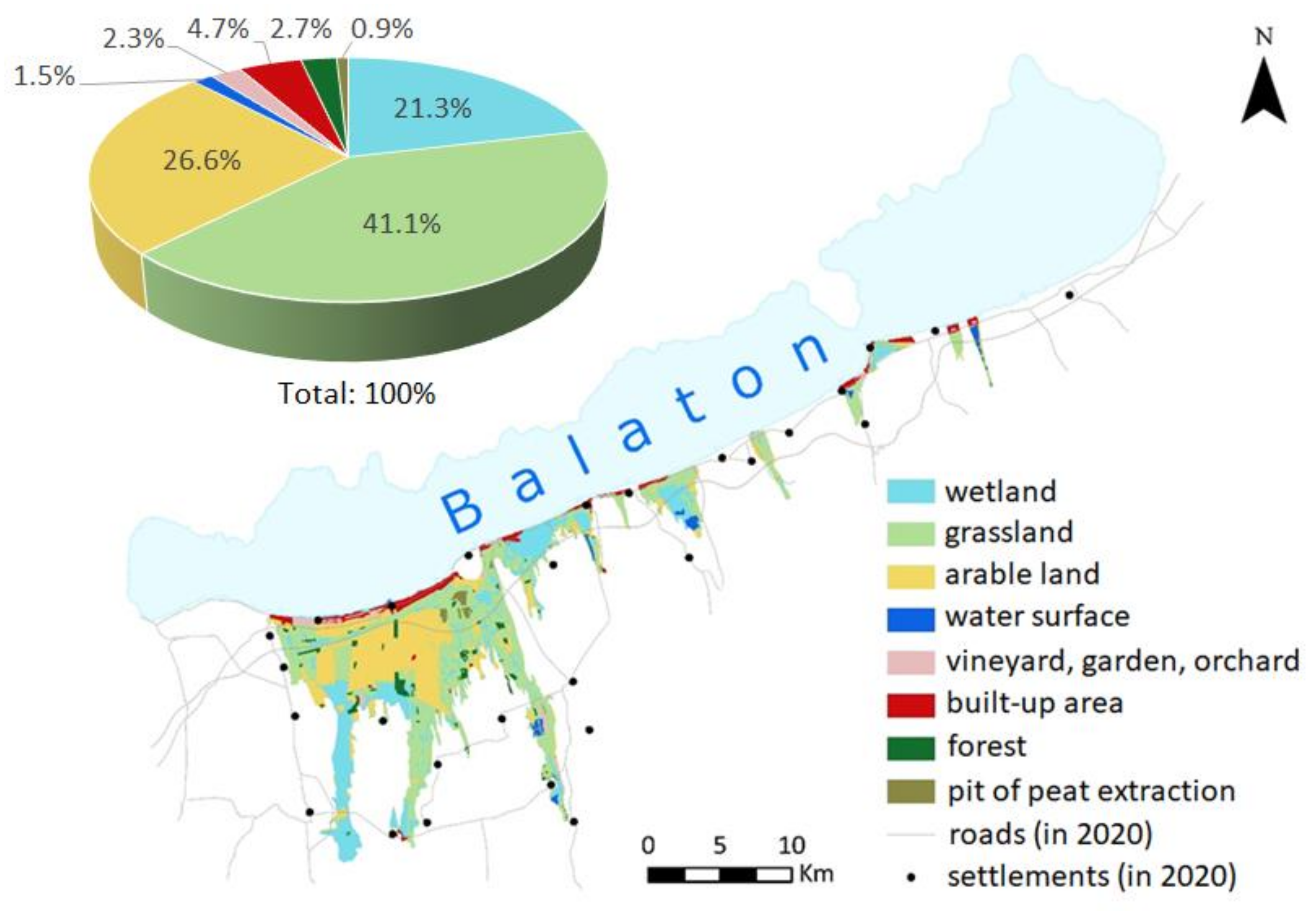
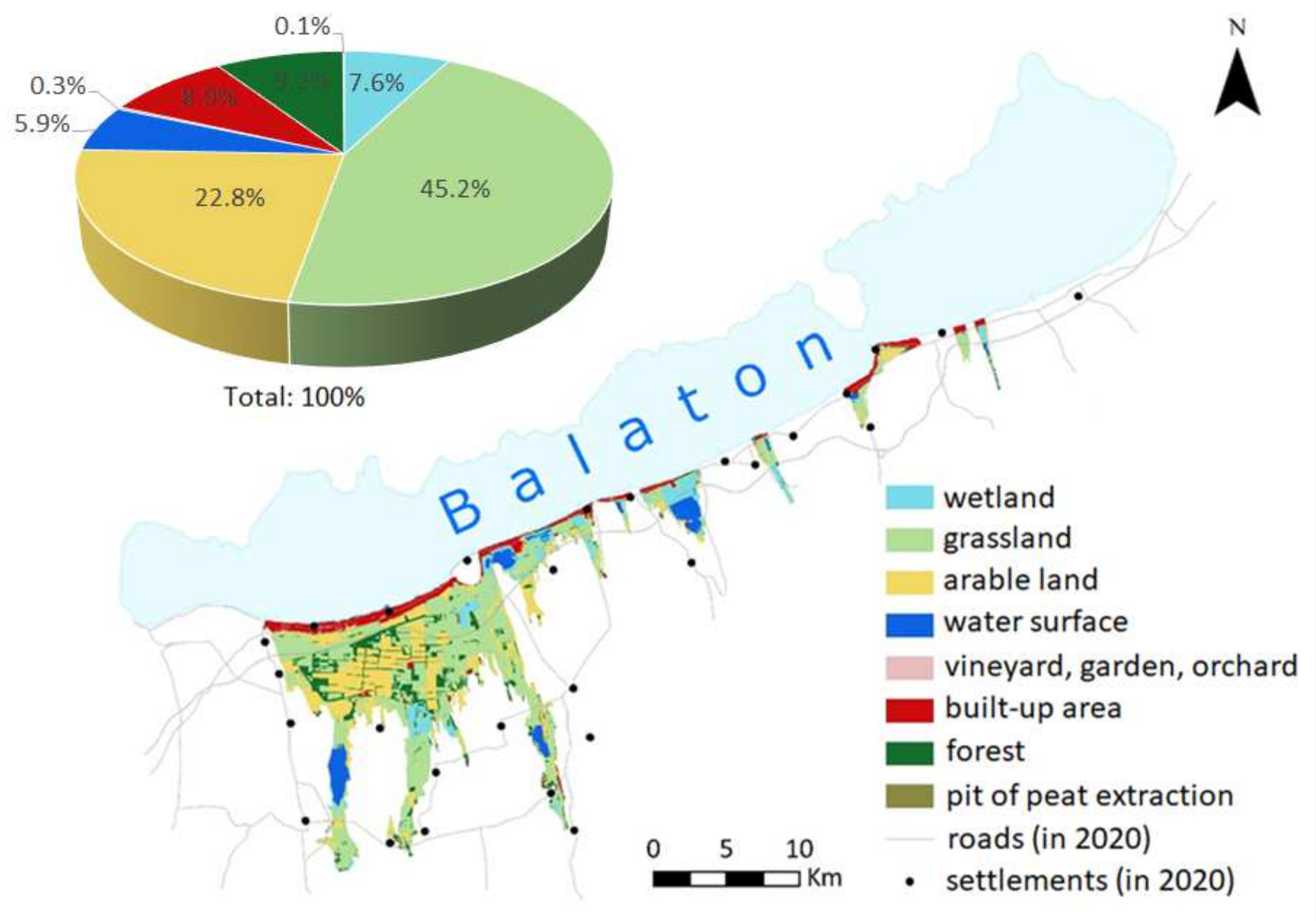



| Forest | Arable Land and Grassland | Water Surface | Built-up Area | |
|---|---|---|---|---|
| Forest | 94.1% | 0.0% | 0% | 0% |
| Arable land and grassland | 5.7% | 99.8% | 0% | 50.3% |
| Water surface | 0.0% | 0.0% | 99.8% | 0% |
| Built-up area | 0.2% | 0.2% | 0.1% | 49.7% |
| Total | 100% | 100% | 100% | 100% |
| Class | TE (m) | MPE (m) | NP (pc) | CA (ha) | MPS (ha) | PSSD (ha) | DIVISION (%) | SPLIT (-) | MESH (ha) |
|---|---|---|---|---|---|---|---|---|---|
| Wetland | 323,446.77 | 23,103.34 | 14 | 14,196.59 | 1014.04 | 2817.37 | 37.72 | 1.61 | 8841.68 |
| Grassland | 343,631.31 | 4772.66 | 72 | 3985.31 | 55.35 | 132.35 | 90.67 | 10.72 | 371.80 |
| Arable land | 8896.67 | 1112.08 | 8 | 52.97 | 6.62 | 10.09 | 58.47 | 2.41 | 22.00 |
| Water surface | 71,194.18 | 2157.40 | 33 | 485.93 | 14.73 | 24.40 | 88.65 | 8.81 | 55.16 |
| Vineyard, garden, orchard | 6826.77 | 2275.59 | 3 | 111.43 | 37.14 | 48.77 | 9.21 | 1.1 | 101.17 |
| Bulit-up area | 454.47 * | 454.47 * | 1 * | 0.71 * | 0.71 * | 0.00 * | 0 * | 1 * | 0.71 * |
| Forest | 77279.59 | 2862.21 | 27 | 646.21 | 23.93 | 59.18 | 73.65 | 3.79 | 170.29 |
| Class | TE (m) | MPE (m) | NP (pc) | CA (ha) | MPS (ha) | PSSD (ha) | DIVISION (%) | SPLIT (-) | MESH (ha) |
|---|---|---|---|---|---|---|---|---|---|
| Wetland | 385,407.39 | 10,416.42 | 37 | 9972.08 | 269.52 | 1197.51 | 43.94 | 1.78 | 5590.27 |
| Grassland | 454,046.88 | 11,351.17 | 40 | 8610.69 | 215.27 | 469.37 | 85.61 | 6.95 | 1238.67 |
| Arable land | 39,354.75 | 1639.78 | 24 | 312.10 | 13.00 | 21.24 | 84.72 | 6.55 | 47.68 |
| Water surface | 81,802.50 | 1076.35 | 76 | 367.47 | 4.84 | 8.29 | 94.82 | 19.31 | 19.03 |
| Vineyard, garden, orchard | 12,050.32 | 2410.06 | 5 | 101.72 | 20.34 | 21.77 | 57.10 | 2.33 | 43.64 |
| Bulit-up area | 1518.40 * | 759.20 * | 2 * | 4.54 * | 2.27 * | 1.76 * | 19.93 * | 1.25 * | 3.64 * |
| Forest | 12,551.75 | 4183.92 | 3 | 110.51 | 36.84 | 21.55 | 55.26 | 2.23 | 49.45 |
| Class | TE (m) | MPE (m) | NP (pc) | CA (ha) | MPS (ha) | PSSD (ha) | DIVISION (%) | SPLIT (-) | MESH (ha) |
|---|---|---|---|---|---|---|---|---|---|
| Wetland | 465,272.38 | 10,574.37 | 44 | 13,022.82 | 295.97 | 1440.86 | 43.86 | 1.78 | 7310.41 |
| Grassland | 392,611.98 | 5948.67 | 66 | 4368.32 | 66.19 | 101.29 | 94.94 | 19.75 | 221.21 |
| Arable land | 235,535.94 | 2403.43 | 98 | 1285.91 | 13.12 | 16.64 | 97.34 | 37.59 | 34.21 |
| Water surface | 130,787.29 | 1816.49 | 72 | 533.35 | 7.41 | 24.52 | 83.4 | 6.02 | 88.54 |
| Vineyard, garden, orchard | 11,680.28 | 1668.61 | 7 | 78.72 | 11.25 | 18.14 | 48.54 | 1.94 | 40.51 |
| Bulit-up area | 8113.88 | 1014.24 | 8 | 31.11 | 3.89 | 6.76 | 49.73 | 1.99 | 15.64 |
| Forest | 17,355.24 | 1577.75 | 11 | 159.65 | 14.51 | 25.59 | 62.66 | 2.68 | 59.62 |
| Class | TE (m) | MPE (m) | NP (pc) | CA (ha) | MPS (ha) | PSSD (ha) | DIVISION (%) | SPLIT (-) | MESH (ha) |
|---|---|---|---|---|---|---|---|---|---|
| Wetland | 191,552.80 | 4353.47 | 44 | 4042.16 | 91.87 | 236.54 | 82.66 | 5.77 | 700.89 |
| Grassland | 413,967.40 | 14,274.74 | 29 | 9775.80 | 337.10 | 785.50 | 77.83 | 4.51 | 2167.48 |
| Arable land | 337,861.30 | 3796.19 | 89 | 3730.24 | 41.91 | 79.48 | 94.84 | 19.36 | 192.64 |
| Water surface | 33,110.71 | 2365.05 | 14 | 471.52 | 33.68 | 64.14 | 66.95 | 3.03 | 155.84 |
| Vineyard, garden, orchard | 50,524.74 | 3886.52 | 13 | 671.46 | 51.65 | 111.19 | 56.66 | 2.31 | 291.02 |
| Bulit-up area | 62,093.45 | 2822.43 | 22 | 722.81 | 32.86 | 52.41 | 83.89 | 6.21 | 116.47 |
| Forest | 2223.07 * | 1111.54 * | 2 * | 7.63 * | 3.82 * | 0.83 * | 47.63 * | 1.91 * | 4.00 * |
| Mine | 11,727.35 | 732.96 | 16 | 57.54 | 3.60 | 4.31 | 84.77 | 6.57 | 8.76 |
| Class | TE (m) | MPE (m) | NP (pc) | CA (ha) | MPS (ha) | PSSD (ha) | DIVISION (%) | SPLIT (-) | MESH (ha) |
|---|---|---|---|---|---|---|---|---|---|
| Wetland | 329,670.60 | 1985.97 | 166 | 4140.06 | 24.94 | 123.51 | 84.62 | 6.50 | 636.62 |
| Grassland | 613,076.74 | 10,391.13 | 59 | 8006.30 | 135.70 | 563.47 | 69.08 | 3.23 | 2475.42 |
| Arable land | 294,053.07 | 3341.51 | 88 | 4985.90 | 56.66 | 296.70 | 67.70 | 3.10 | 1610.37 |
| Water surface | 37,063.38 | 1323.69 | 28 | 296.69 | 10.60 | 15.73 | 88.56 | 8.74 | 33.95 |
| Vineyard, garden, orchard | 62,964.57 | 2623.52 | 24 | 448.59 | 18.69 | 26.23 | 87.63 | 8.08 | 55.51 |
| Bulit-up area | 98,933.38 | 2198.52 | 45 | 914.73 | 20.33 | 45.36 | 86.71 | 7.53 | 121.53 |
| Forest | 81,770.83 | 1075.93 | 76 | 517.85 | 6.81 | 12.98 | 93.91 | 16.43 | 31.53 |
| Mine | 19,014.12 | 1118.48 | 17 | 169.06 | 9.94 | 18.39 | 74.00 | 3.85 | 43.96 |
| Class | TE (m) | MPE (m) | NP (pc) | CA (ha) | MPS (ha) | PSSD (ha) | DIVISION (%) | SPLIT (-) | MESH (ha) |
|---|---|---|---|---|---|---|---|---|---|
| Wetland | 193,122.81 | 1874.98 | 103 | 1479.17 | 14.36 | 31.73 | 94.29 | 17.51 | 84.45 |
| Grassland | 806,394.27 | 3199.98 | 252 | 8798.29 | 34.91 | 214.66 | 84.60 | 6.49 | 1354.72 |
| Arable land | 491,248.25 | 2506.37 | 196 | 4450.00 | 22.70 | 45.10 | 97.48 | 39.63 | 112.28 |
| Water surface | 86,233.15 | 1064.61 | 81 | 1146.34 | 14.15 | 55.53 | 79.76 | 4.94 | 232.04 |
| Vineyard, garden, orchard | 44,594.98 | 327.90 | 136 | 63.66 | 0.47 | 0.61 | 98.01 | 50.15 | 1.27 |
| Bulit-up area | 188,153.52 | 1679.94 | 112 | 1731.97 | 15.46 | 78.38 | 76.17 | 4.20 | 412.77 |
| Forest | 419,514.60 | 1319.23 | 318 | 1794.18 | 5.64 | 24.08 | 93.96 | 16.55 | 108.41 |
| Mine | 2327.46 * | 2327.46 * | 1 * | 14.48 * | 14.48 * | 0 * | 0 * | 1 * | 14.48 * |
| Class | TE (m) | MPE (m) | NP (pc) | CA (ha) | MPS (ha) | PSSD (ha) | DIVISION (%) | SPLIT (-) | MESH (ha) |
|---|---|---|---|---|---|---|---|---|---|
| Wetland | 399,930.11 | 3149.06 | 127 | 3465.62 | 27.29 | 108.32 | 86.81 | 7.58 | 457.28 |
| Grassland | 589,972.78 | 3277.63 | 180 | 5721.48 | 31.79 | 139.02 | 88.82 | 8.94 | 639.85 |
| Arable land | 352,807.90 | 2416.49 | 146 | 3216.84 | 22.03 | 110.28 | 82.16 | 5.60 | 573.96 |
| Water surface | 69,585.09 | 2577.23 | 27 | 1277.64 | 47.32 | 90.64 | 82.71 | 5.78 | 220.94 |
| Vineyard, garden, orchard | 62,235.38 | 1296.57 | 48 | 231.14 | 4.82 | 8.81 | 90.94 | 11.03 | 20.95 |
| Bulit-up area | 180,956.65 | 3290.12 | 55 | 2144.20 | 38.99 | 125.72 | 79.27 | 4.82 | 444.41 |
| Forest | 961,701.45 | 695.37 | 1383 | 3076.96 | 2.22 | 15.49 | 96.42 | 27.96 | 110.06 |
| Scrub | 131,564.94 | 1124.49 | 117 | 331.15 | 2.83 | 9.49 | 89.54 | 9.56 | 34.63 |
Publisher’s Note: MDPI stays neutral with regard to jurisdictional claims in published maps and institutional affiliations. |
© 2021 by the authors. Licensee MDPI, Basel, Switzerland. This article is an open access article distributed under the terms and conditions of the Creative Commons Attribution (CC BY) license (https://creativecommons.org/licenses/by/4.0/).
Share and Cite
Németh, G.; Lóczy, D.; Gyenizse, P. Long-Term Land Use and Landscape Pattern Changes in a Marshland of Hungary. Sustainability 2021, 13, 12664. https://doi.org/10.3390/su132212664
Németh G, Lóczy D, Gyenizse P. Long-Term Land Use and Landscape Pattern Changes in a Marshland of Hungary. Sustainability. 2021; 13(22):12664. https://doi.org/10.3390/su132212664
Chicago/Turabian StyleNémeth, Gergő, Dénes Lóczy, and Péter Gyenizse. 2021. "Long-Term Land Use and Landscape Pattern Changes in a Marshland of Hungary" Sustainability 13, no. 22: 12664. https://doi.org/10.3390/su132212664
APA StyleNémeth, G., Lóczy, D., & Gyenizse, P. (2021). Long-Term Land Use and Landscape Pattern Changes in a Marshland of Hungary. Sustainability, 13(22), 12664. https://doi.org/10.3390/su132212664








